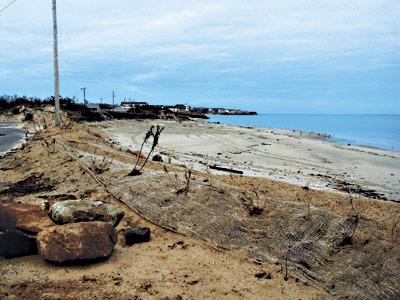Dredging Nears an End

Broader shores at Sammy’s Beach west of the Three Mile Harbor Inlet, and also at Soundview west of the Montauk Harbor Inlet, provided scenic evidence this week that the dredging of both inlets was complete — well, almost.
The Three Mile Harbor job has been abbreviated. Sand shoals were to be removed from the harbor inlet but also from a channel at the harbor’s south end. Within the last few days, a decision has been made not to dredge the south end.
Bill Hillman, chief engineer for the Suffolk Department of Public Works, the agency responsible for the work, said that 80,000 cubic yards had been removed from the harbor inlet, “but there are only about 1,700 cubic yards in the south end. It’s not worth moving the dredge.” Instead, Mr. Hillman said his department would work with the town to place buoys warning mariners of shoal areas in the channel. He said the channel, originally 150 feet wide, was now about 75 feet wide. The south end of the harbor has not been properly dredged for 30 years.
Sand from the Three Mile Harbor Inlet was pumped to Sammy’s Beach by the Gibson and Cushman company of Bay Shore without the need to cross private property, as was feared. While Sammy’s beach was not badly eroded, the new sand should serve as an added defense against winter storm damage.
As usual, the sand taken from clogged inlets and from the large shoal at the south end of Georgica Pond is viewed as a return, however brief, of eroded beaches.
The rock jetties at Montauk and Three Mile Harbor are responsible for accelerating erosion down-drift of the prevailing tidal currents and for causing sand to pile up in the inlets themselves. Sand carried from the inlets via pipelines connected to hydraulic dredges has rebuilt lost beaches, although rebuilding beaches was not the primary goal.
Shoaling posed serious navigational hazards in both inlets, and the same hazards exist in the Accabonac Harbor Inlet and in Napeague Harbor’s east channel, which is now virtually closed by sand buildup. Larry Penny, East Hampton Town’s director of natural resources, said the town had applied to the State Department of Environmental Conservation to extend permits to excavate the inlets at Napeague and Accabonac Harbors. The excavations must be done by Jan. 15, when such work will have to be suspended to comply with a federal mandate to protect breeding winter flounder.
Diane McNally, clerk of the East Hampton Town Trustees, said that this time around sand from an excavation of Napeague’s east channel would not be used to rebuild beaches in the Lazy Point area, as residents have requested, because the state permit would have to be amended. Dredged material will be stored at Goff Point instead.
Money for both excavations is expected to come as a result of the town’s having applied for state and federal disaster aid after last year’s Christmas northeaster — approximately $142,000 for the work at Accabonac Harbor and between $30,000 and $40,000 for Napeague.
On Tuesday, the Montauk Coast Guard reported that dredging in the Montauk Harbor Inlet had ceased and the contractor, the North American Landscaping, Construction, and Dredge Company, was awaiting a final survey before the Army Corps of Engineers signs off on the work. Originally planned for 2013, the dredging of the inlet was moved up to early October because of a dangerous shoal that had grown from the east side to the center of the channel.
In late October, problems with the 12-inch-diameter pipeline caused it to float to the surface. A number of boats hit the pipe on their way in and out of the harbor. After Supervisor Bill Wilkinson held a meeting with mariners, Army Corps representatives, the contractor, and the Coast Guard, the problem was ironed out.
Assuming the Army Corps signs off on it, the $414,000 project, when completed, will have removed between 15,000 and 20,000 cubic yards from the channel. An Army Corps study to find a long-term solution to the severe erosion on the Soundview side of the Montauk Harbor jetties is due next year.
The trustees will again hire a contractor, or perhaps more than one, to excavate sand from the large flat at the south end of Georgica Pond. The sand is purchased from the trustees by coastal engineers who use it to rebuild beaches where erosion threatens private property to the west of the pond.
Ms. McNally said that following last year’s confusion over a bidding process for the Georgica job, an effort would be made this year to have contractors interested in the excavation work — which includes trucking sand away from the pond — enter into cooperative arrangements. A similar process is used by Southampton trustees.
Ms. McNally explained that the D.E.C. allows 12,500 cubic yards of sand to be taken from Georgica Pond each calendar year. “For the last couple of years, we have not gotten that much out. We’ll try to get as much as we can,” she said.
This year, the trustees will charge a flat rate of $7 per cubic yard for the sand, which could go up to $7.50 per cubic yard in January. Contractors will have from today until Jan. 15 to take the sand.
